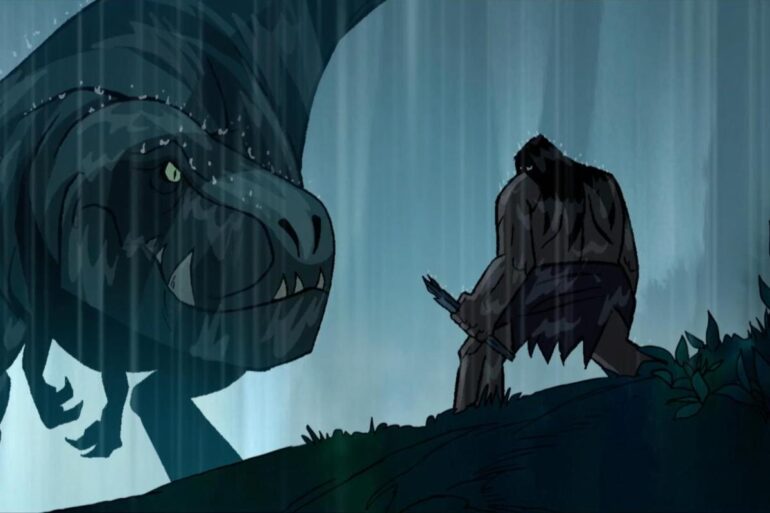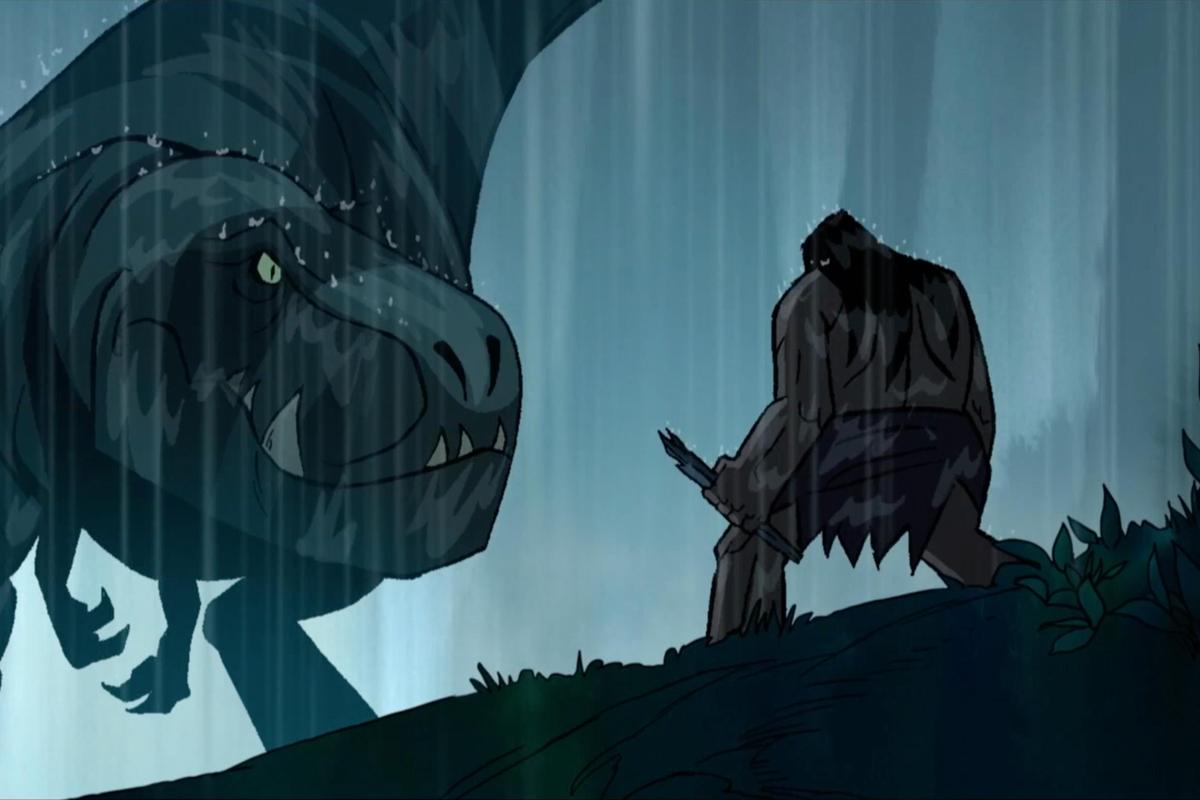When I first saw ads for Primal, sometimes stylized as Genndy Tartakovsky’s Primal just to make clear that it’s an auteur piece, I was very much looking forward to the new action show starring a caveman and T-rex team from the guy who made Samurai Jack and Star Wars: Clone Wars. I was not at all expecting a show that dealt with dinosaur PTSD and that, more than any other feeling, left me with a deep sadness. But that’s part of what makes Primal so special.
Within the first five minutes of the first episode it becomes clear that this isn’t the fun ride that Samurai Jack and Clone Wars were. Our lead human character, referred to as Spear by the episode summaries, returns to his partner and children from a fishing outing just in time to witness them violently killed and eaten by a group of horned T-rexes.
While this shockingly brutal opening could take the turn into a cathartic revenge tale, that possibility and the hope for that storyline are immediately undercut when Spear then walks up to a cliff and considers leaping to his death. He decides against it, but more than any anger or desire for vengeance, what we are left with is his sadness and pain. And this sadness is what characterizes the show most emotionally.
What characterizes the show most of all though is the purely visual storytelling. There is no dialogue, as neither of the central pair has developed a capacity for language (though that doesn’t stop them from being vocal from time to time), leaving every story beat to be conveyed only through the action on screen.
The animation style here is necessarily very clear, allowing the audience to see every step of the action, as is standard for Tartakovsky’s two dimensional work, but it also feels grittier than his previous series. Primal looks hand drawn in every frame. There are thick black lines that sometimes look like they were drawn in charcoal, and there is blur in the action sequences that make it feel visceral without sacrificing clarity. There’s great use of shadow and silhouette throughout, and the ultrawide 2.39:1 aspect ratio makes every moment feel cinematic.
The purely visual storytelling forces viewers to pay attention: you can’t watch Primal and scroll Twitter or play a game on your phone at the same time. This makes the viewing experience more immersive and emotionally resonant. This plays out particularly in relation to the creatures that our heroes fight and often kill. Because there is no dialogue to characterize these creatures as villainous, our understanding of their motivations is the same as that of our heroes: they are simply doing what they must to survive.
The most affecting instance of this is episode 3, aptly titled “A Cold Death,” in which an old woolly mammoth is left behind by its herd before being attacked, killed, and eaten by Spear and our dinosaur heroine Fang. This mammoth is in no way a threat to our protagonists, and in fact the first few minutes of the episode are spent with it, showing that it is too old to keep up with its herd which is heartbreaking. As the episode goes on the herd returns for their elder and engages Spear and Fang in a brutal fight. But instead of fighting to the death, the herd leaves them once one of the elder’s tusks is returned, allowing them to grieve properly.
This ritual is one of many that we see throughout the show as our heroes move through different spaces and interact with a variety of species and societies over the course of the show. Because of this, the show sometimes feels like the archetypal western stories of a hero coming to a town and saving it before riding off into the sunset – in fact at the end of episode 4 Spear and Fang literally ride into the sunrise. Adding to this western feel are the ultrawide screen shots of vast landscapes, contrasted with frequent close ups of characters’ eyes to convey their thought processes à la Sergio Leone.
But Primal isn’t constrained by genre. There are elements of fantasy, science fiction (arguably the show is mostly a science fiction show given its anachronisms), and horror. There are creatures that could possibly have existed, but feel much more like something from Lord of the Rings than something from prehistory, like the giant spider. At another point, there is a concoction that lends the drinker incredible strength while rendering them temporarily monstrous, which leads to the goriest and most satisfying short Hulk story that I’ve ever seen. In a number of episodes our heroes spot a pair of eyes in the darkness, and one episode goes so far as to significantly engage in the formal language of horror by using point-of-view shots to show what an unseen assailant sees, never showing the creature itself until the climax of the episode.
Primal can get a bit repetitive as a number of episodes play out with Spear and Fang defeating some antagonist, only to be attacked by either a larger creature or a swarm of the same creatures that they’ve already defeated. This gets better in the second half as the show loosens up and becomes a bit of a genre playground, engaging in more ambitious world building. And while for the most part each episode is self contained, we do see the relationship between Spear and Fang develop over time into something that’s quite sweet and can often be funny. The sadness at the heart of the show makes this relationship more meaningful and makes the moments of humor true comic relief.
There are moments of beauty sprinkled throughout the show, too, many of which focus on something as simple as the two characters smiling at each other during a tranquil break from the violence of the world around them. The animation of their faces is also surprisingly evocative given the simplicity of the art style, allowing the audience to identify with the range of their pain, anger, desperation, and joy.
The great score by Tyler Bates and Joanne Higginbottom matches and deepens the emotional register of these scenes. Bates, who is known for working with Rob Zombie and Zack Snyder, does some of his best work here. The music is often heavily percussive during action scenes, while synth and string based in more emotional scenes, but it always feels cohesive. It’s music made to help carry some of the narrative given the lack of dialogue and it is entirely up to the task.
While I might have wanted Primal to be a purely “cool” action show that simply upped the violence and gore of Tartakovsky’s previous series, I don’t think that show would be nearly as special as Primal really is. This is a show that makes you feel a range of emotions, focused on a deep sense of sadness and loss, without sacrificing the visual splendor of gorgeously animated action scenes.
The only complaint I have overall is that the show may sometimes be too brutal, potentially veering into edgy territory, but because each loss and moment of brutality is afforded true emotional weight, it’s not a very strong complaint. More specifically though, it is a bit disappointing and frustrating that the season ends on a cliffhanger after almost every other episode has been a perfectly self-contained story. It makes me worry that season 2 will abandon the episodic form that works so well in season 1 for a more streamlined narrative. But even if that is the case, the animation and the emotional connection I’ve now built to these characters will certainly keep me coming back for more.
READ NEXT: 5 Reasons Why You Should Watch The Queen’s Gambit on Netflix
Some of the coverage you find on Cultured Vultures contains affiliate links, which provide us with small commissions based on purchases made from visiting our site.


